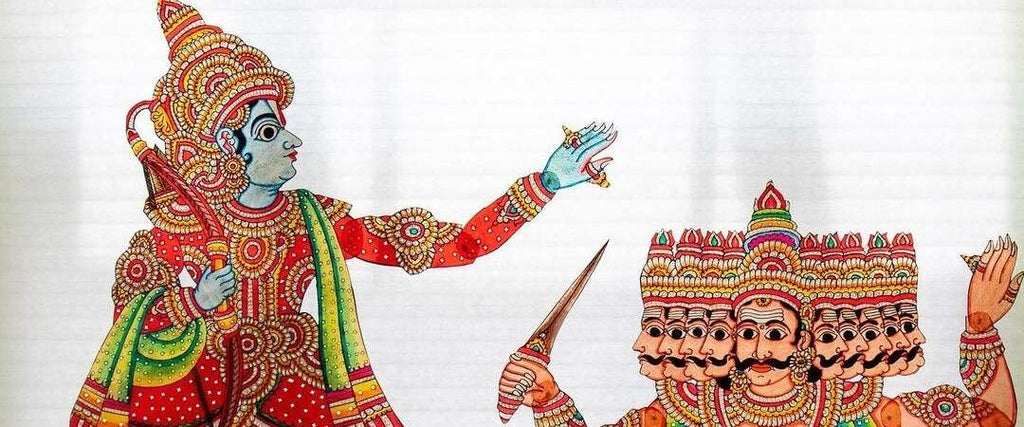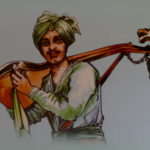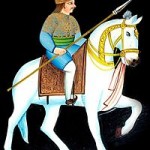From Telugu Aatalu we move to Tholu Bommalaatalu. ACP’s Continuing Series on Folk Arts covers the traditional artistry of leather puppets.
Introduction

Culture is not simply graanthikam or even maandalikam, but also jaanapaadham. All too often, those self-appointed grandees of ‘good culture’ get lost in pedantry and self-praise. Forgetting themselves, some sections of them propound their pitrs over the devas, and mahapaapa over Mahadeva. The net result is that the medium of communicating high culture becomes lost.
It is for that reason that along with high culture or even general culture, there is mass culture. The folk arts have long been a celebrated medium of transmitting a people’s language, identity, and yes, culture. The values, morals, and inspirational stories of a region are often best passed on not through the written word, but rather, through theatrical performance. The classical indic tradition has always made room not just for maarga (spiritual) or desi (regional), but also jaanapaadham (folk).
Tholu Bommalaata, or leather puppetry, has long been a celebrated aspect of Telugu culture. Though all-India in its inheritance and practice, this art has been made distinct by the Andhras —true to their penchant for the grand and grandiose.
History
“Leather puppet shadow play is one of the most ancient performing folk art form known to Andhras from 3rd cen-tury B.C. Historians and art critics opine that it spread to Java, Malaysia and Indonesia from Andhra.” [1, 147]
The history of Tholu Bommalaata, therefore, is very ancient in Andhra, which was not just a receiver of Sanskritic High culture, but also transmitter to South East Asia. The ancient connection of Trilinga desa to Burma (modern Myanmar) is well-known and documented, for example. Nevertheless, this art form remained prominent in its homeland throughout the ages.
“It was popular during the reign of Satavahanas, Pallavas, Kakatiyas, Vijayanagara Kings and finally reached its zenith when Telugu Naik Kings ruled over Tanjore and Madura.” [1, 147] The authoritative Palkuriki Somanatha makes reference to it in his ‘Panditaradhya Charitra’. Ancestrally, it was practiced by artistes among the Ata Gollalu (Shepherd) and Jangam (Saivite ascetic) communities. At present, Bondili (Bundeli) and Are (Maraatthi) transplants who assimilated into the Andhra population, practice the art. [1, 147]
“The three kinds of puppet shows prevalent in Andhra were the leather shadow puppet shows called Tholu Bommalata, the string puppet shows called Sutram Bommalata and the wooden puppet shows called Koyya Bommalata. Tholu Bommalata was the most popular of these.” [2]
Characteristics
“A troupe of shadow puppeteers consists of eight to twelve artistes, two females for singing and speaking for female roles, two males for singing and speaking for male characters”.[1, 147-148]
These leads are then complemented by three instrumentalists to play vaadhyas such as sruthi and cymbals, as well as an assistant for general support in supply and maintenance. The material for the puppets is sourced from the hides of goat and deer. The leather is carefully tanned, thinned to the point of translucence, cut into form, and dyed with natural colour. Kakada, a local vegetable dye, is used to provide this vibrance. [2]
The actual size of these puppets can vary anywhere from 1 to 6 feet, and are assigned their proportions based on age and nature of the characters (i.e. humans vs demons). These are then perforated and adorned with jewellery. [1, 148] Animals too feature in these productions. But as usual, it is the divine that inspires the most.
“Sometimes three to four puppets are prepared for one character, like Rama as a boy, Rama in exile, Rama in the battle field and Rama during coronation.” [1, 148] These puppets are protected and transported in a puppet box known as Ganiyam, which is carefully guarded and cherished by the troupe. The puppet itself is manipulated and animated through the use of sticks attached to each limb or joint. [1, 148] Some large puppets can have as many as thirteen moveable joints. [2]
Prior to each performance, a temporary theatre is set up along with a thatched roof. It remains closed on one side and open on the other three, and possesses a white screen that is fastened to the accompanying poles. A two foot wide black cloth is then attached as a border to the screen (and masks the movements of the puppeteers themselves). Finally, castor oil lamps are positioned at even spaces behind the curtains to illuminate the richly coloured devices.
“Plays commence with Nata raga and con-clude with Surati raga“. [1. 149] Performances invariably invoke both Ganesha and Sarasvathi before the main event. Themes and storylines are typically typified by the Hindu Legendarium, with dramas frequently performing Sundara kaanda, Lakshmana Murcha, Raavana Vadha, and Kusalava Katha from Raamaayana, along with Sisupaala Vadha from Mahabhaaratha, and Prahalaadha Katha from the Bhaagavatha Puraana. Historical plays featuring ancient and medieval kings are also produced, with song and dialogue alike committed to memory. [1, 149]
The biggest takeaway, however, is much like the Telugu way of thinking. If Telugu cinema is the Baahubali of the Indian box office, then Tholu Bommalaata is the grand canvas of Telugu folk arts.
“Andhra puppets are the largest of Indian puppets having jointed limbs of the body like neck, shoulders, elbows, wait, knees and ankles. Each troupe possess 100 to 150 puppets to cater to the variety of themes which they present.” [1, 148]
Future
The future of Tholu Bommalaata remains bleak. Thanks to television, cinema, smart phones, and video games, young and old alike have no time for the traditional arts. Patronage remains even more sparse than audience members.
The nature of this art is that it is also a craft. Environmentally (and religiously) friendly leather-making and dyeing processes makes for a sustainable medium for many practical purposes. Not only can puppets and toys be manufactured, but lampshades and wall-hangings as well. Though there are myriad options for the purchasing public to patronise, revenue has been sparse.
Despite this adversity, stalwart sections among rural denizens preserve the art form. “A few families of these artistes inhabit, Sarvasiddhi and Sringavarapu kota in Visakhapatnam district, Peddapuram, Samarlakota, Rajamahendravaram, Tallarevu and Nadhavapatnam in East Godawary district, Bommalatapalli, Nimmala kunta and Raydurgam in Anatapuram district, Kamalapuram in Cuddapah district, D.C. Palli, in Nellore district and Rajapuram in Nalgonda district.” [1, 147]
One prominent artisan in a long line of the tradition recently conducted a workshop. “A 15th-generation artisan, Kullayappa, who is from Anantapur, talked about the art’s birth, development and his family’s engagement with it. He also demonstrated how a puppet is made using traditional tools. ” [3] Is there not an obligation from the Telugu public to support such guardians of an ancient art?
Handmade Trapezoid shape, big, Tholu bommalata Table lamp with multicolour God Ganesha.
.
Buy at https://t.co/0uWl2ZEjHi
Product link: https://t.co/PKRarfWS91
.#lamp #lampshades #homedecor #decorativelight #tholubommalata #shilphaat pic.twitter.com/jTOGUUyMiA— Shilphaat.com (@Shilphaat) May 29, 2021
References
- Raju, B. Rama. Folklore of Andhra Pradesh. New Delhi: Natl.Book Trust. 2014
- ‘Power of the shadow puppets’. The Hindu. Sep 5, 2011. https://www.thehindu.com/arts/crafts/power-of-the-shadow-puppets/article2426235.ece
-
‘Artisans struggle to keep puppet tradition of Tholu Bommalata alive’. https://timesofindia.indiatimes.com/city/hyderabad/artisans-struggle-to-keep-puppet-tradition-of-tholu-bommalata-alive/articleshow/72175204.cms






